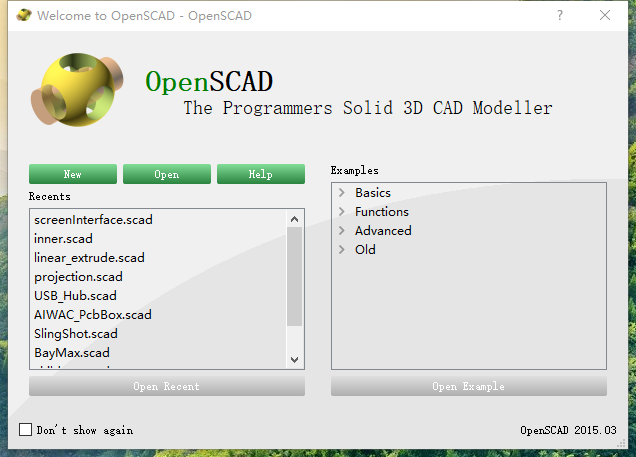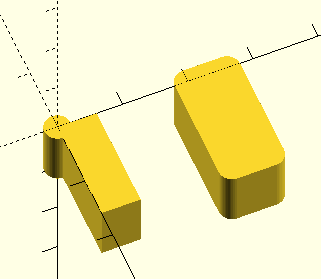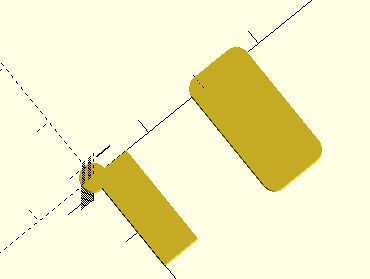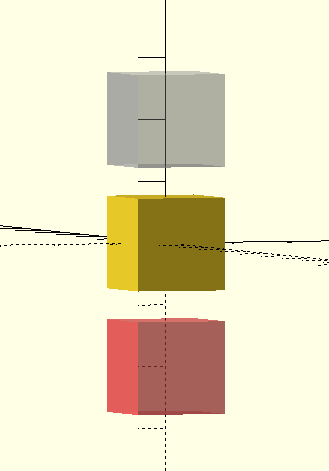openscad 3Dmodels 笔记
参考链接
如何快速上手
打开openSCAD后界面如下:

选择其中的examples,从basic看起。配合官方文档中的first step部分,和官方文档——代码写法即可很快上手。
概述
- 默认界面左边是代码,右边是预览图
- Ctrl + D 可注释选中行(从edit菜单栏中得知)
- 以下按钮预览(鼠标停留可显示文字preview)

命令
几何体
cube(10); //边长为10的正方体,锚点在其一角
cube([2,3,4]); //长宽高分别为2,3,4的长方体,锚点在其一角
cube(15, center=true); //边长为15的正方体,锚点在其中心
sphere(10); //半径为10的球体
polygon( points=[[0,0],[8,4],[4,8],[4,12],[12,16],[0,20]] ); //这几个点顺次连接构成的几何体
几何变换
translate([-24,0,0]) //平移
union() //并
intersection //交
difference() // 差
hull() //凸包,详情请百度
例子:

linear Extrude
linear_extrude(
height = fanwidth,
center = true,
convexity = 10,
twist = -fanrot,
slices = 20,
scale = 1.0,
$fn = 16) {...}
minkowski() (倒角,圆角,bevel)
例一:minkowski()直接用于三维物体
height = 10;
length = 10;
width = 20;
bevelRadius = 2;
$fn=50;
cube([length-2*bevelRadius, width-2*bevelRadius,height]);
cylinder(r=bevelRadius,h=height);
translate([20,0,0])
minkowski()
{
cube([length-2*bevelRadius, width-2*bevelRadius,height/2]);
cylinder(r=bevelRadius,h=height/2);
}



例二:minkowski()用于二维物体(之后可以叠加linear Extrude)
height = 10;
length = 10;
width = 20;
bevelRadius = 2;
linear_extrude(height = height)
square([length-2*bevelRadius, width-2*bevelRadius]);
linear_extrude(height = height)
circle(r=bevelRadius);
$fn=50;
translate([20,0,0])
linear_extrude(height = height)
minkowski()
{
square([length-2*bevelRadius, width-2*bevelRadius]);
circle(r=bevelRadius);
}
效果和例一相同
projection()
projection(cut = true)
import("projection.stl");
rotate_extrude()
绕z轴旋转360°
文字
text(letter,
size=size*22/30,
font="Bitstream Vera Sans",
halign="center",
valign="center");
echo(字符串变量);
会在右边控制台console中第三行左右显示

导入其他文件
import("xxx.stl");
import("projection.stl"); //
use <xxx.scad>
use <logo.scad> //Imports the Logo() module from logo.scad into this namespace
Logo();
特殊显示(透明与高亮)
cube(15,center = true);
translate([0, 0, 20]){
%cube(15,center = true); //% 是透明
}
translate([0, 0, -20]){
#cube(15,center = true); //#是高亮
}
效果如图:

特殊变量
分辨率:$fa, $fs and $fn
The $fa, $fs and $fn special variables control the number of facets used to generate an arc:
-
$fa is the minimum angle for a fragment. Even a huge circle does not have more fragments than 360 divided by this number. The default value is 12 (i.e. 30 fragments for a full circle). The minimum allowed value is 0.01. Any attempt to set a lower value will cause a warning.
-
$fs is the minimum size of a fragment. Because of this variable very small circles have a smaller number of fragments than specified using $fa. The default value is 2. The minimum allowed value is 0.01. Any attempt to set a lower value will cause a warning.
-
$fn is usually 0. When this variable has a value greater than zero, the other two variables are ignored and full circle is rendered using this number of fragments. The default value is 0.
初始视角 $vpr, $vpt and $vpd
- $vpr shows rotation
- $vpt shows translation (i.e. won't be affected by rotate and zoom)
- $vpd shows the camera distance [Note: Requires version 2015.03]


